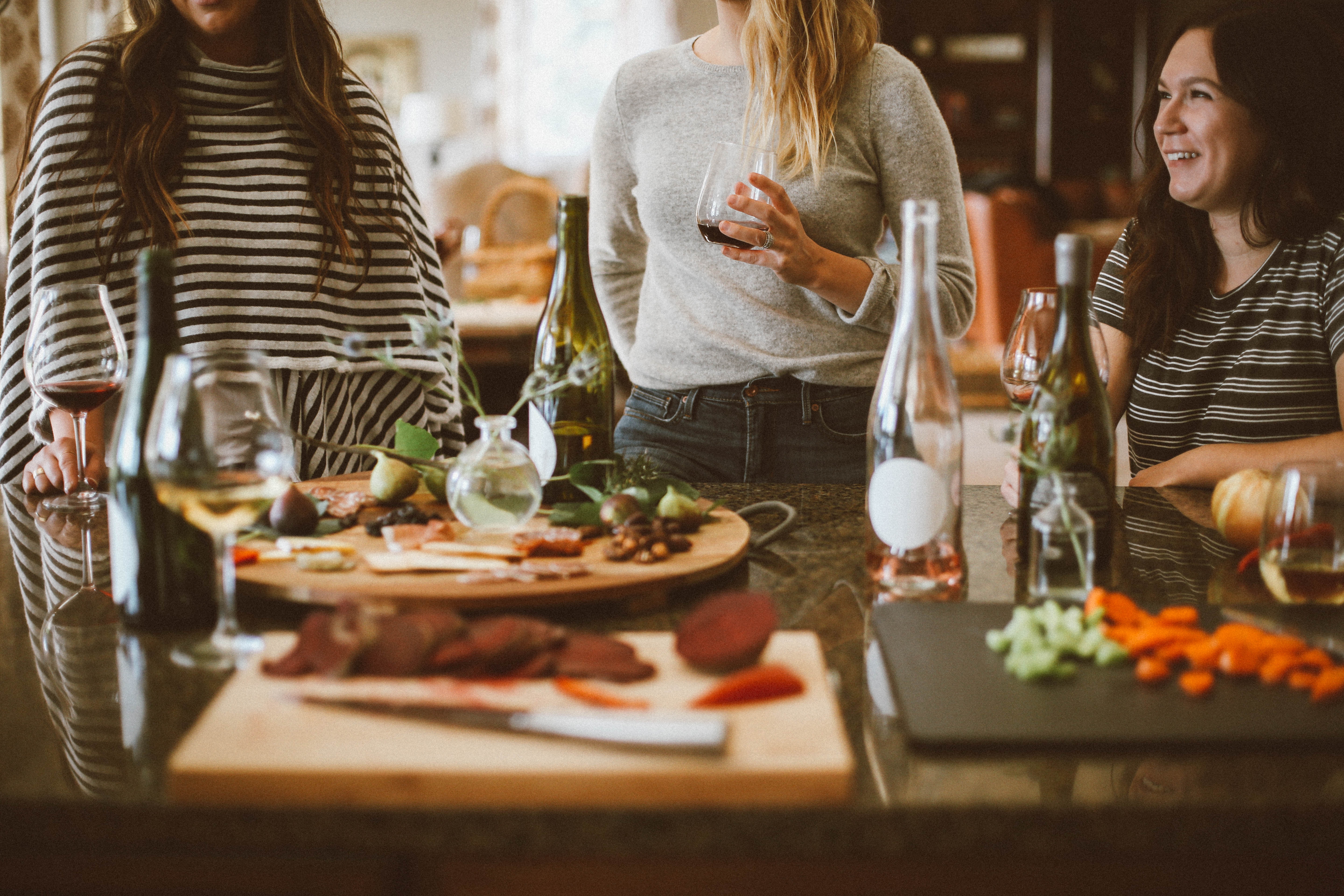You make dozens of choices a day about what to eat. Most of the time, it’s a matter of what’s available and what looks good. If you’re fortunate, you might choose what is healthiest for you.
But…
Do you consider how your friends affect what you eat?
The social context of your meals can change how much you eat, what you order, how quickly you finish your meal, and even how you digest your food. The impact of your friends, family, and colleagues on your diet (and inevitably your waistline) are significant, yet often overlooked.
If you want to truly take control of your eating, here are the social factors that are important to consider for your health.
The Power of Social Belonging
Imagine you are out to dinner and someone at the table orders a drink. You may have considered sticking with water, but when someone decides to get a beverage, it increases the likelihood that you’ll order a drink too.
This isn’t about overt peer pressure. It is about subtle social scripts. You may not really want a drink, but you also don’t want your friend to feel alone in their decision.
It’s silly. I know. But it happens all the time.
There is a tricky shadow of collusion, guilt, indulgence, and perceived judgment at play. You don’t want people to feel left out. At the same time, you don’t want to feel judged for abstaining. Underlying all these thoughts is the unconscious desire for belonging.
In many situations, the emotional need for connection takes precedence over what is best for your body. Consider when your friend shows up at your house with home-baked brownies or when your colleague asks you to split an appetizer at lunch––what do you do?
While these invitations to share food aren’t meant to sabotage your diet, rejecting food that has been offered to you has real social costs. Sharing food, especially something that has been cooked with love, is a bid for connection. Choosing to refrain puts you at a risk for disconnection.
(Read: Why Eating The Same Food Increases People’s Trust And Cooperation)
The Power of Social Mimicry
Your nervous system is wired to prioritize safety, and it uses non-verbal cues to determine if someone might be a threat. If a person looks and acts like you, chances are they are trustworthy. This is one reason why people tend to unconsciously adopt the same body language as the person they’re talking to––mirroring builds trust and rapport.
In dining situations, your eating patterns can synchronize with other people through this unconscious process of social mimicry. For example, if someone raises his or her fork to take a bite, you’re likely to do the same. If the person across from you stops to sip his or her drink, you’re likely to stop and drink, too.
This mimicry can also affect the pace at which you eat, as you are likely to adjust your tempo to better align with your dining partner’s pace. Even if you are at a table by yourself, the pace of the people eating around you can subtly affect how quickly you consume your meal. This is one reason why it is rare to see someone slowly savoring a meal in a loud and hurried food court. The context and ambiance unconsciously discourage it.
The Power of Conversation
The rate and emotional tone of your conversation at the meal can affect your eating habits. For some, a positive and engaging conversation might lead to eating more food as a meta-analysis published in Neuroscience and Behavioral Reviews found. When your conversation is relaxed and calm, you are more likely to shift your nervous system towards parasympathetic dominance which promotes digestion.
In contrast, a tense and unpleasant conversation can nudge your body into a physiological stress state. This slows the production of digestive enzyme and the secretion of gastric juices diminishing your ability to properly digest your meal. The psychological impact of a stressful conversation can go either way in terms of affecting appetite. For some, it might blunt their desire to eat. For others, stress leads to eating more as a way to calm, soothe, or distract yourself from uncomfortable feelings.
There are endless situational variables and individual differences at play in mealtime conversations. Just recognize that you are always eating more than food––you are also consuming conversation.
In addition to the emotional impact of the conversation, the pace of exchange can impact your eating. Meals with lively conversation creates more pauses to both listen and chime in. This continuous shifting of visual (i.e. making eye contact while talking) and verbal attention tend to slow down your consumption of a meal. It’s natural to chew your food while listening, and the more you chew, the easier it is for your body to process and assimilate what you eat. Thus a good conversation can also lead to good digestion.
The Power of Social Permission
Researchers have found that the more people you eat with, the more you tend to eat. (Read: Why Eating with Other People Makes Us Fat). There are numerous ideas about why this happens. In a sharing situation, more people leads to more dishes. More dishes leads to more desire to taste different foods as variety and novelty stimulate appetite and reward centers in the brain. This why your eyes will always always be bigger than your stomach.
Even if you aren’t sharing dishes, meals with large groups are likely to take longer. This means food remains out for longer, so even when you’ve reached the point of satiation, you’re likely to nibble just because it’s there.
Researchers call this type of mindless eating “environmentally induced passive overconsumption.” It explains why, when it comes down to a battle between the environment and willpower, the environment almost always wins. In other words, if someone orders dessert, there’s a good chance you’ll take at least one bite just because it’s there.
When you see people continuing to help themselves, there is unconscious social permission to keep eating. After all, if they have permission to eat more, why don’t you too? As I discuss in my article “The Four ‘C’s that Actually Control What you Eat,” you tend to eat as many plates of food as those dining with you, regardless of whether you initially intended to get an appetizer or go back for seconds.
The Power of Social Identity
Power
Familiarity, culture, gender, and power can also impact your eating in a myriad of ways. For example, eating with a familiar friend typically leads to less inhibited food choices than eating with someone new. For most, this leads to eating more as greater familiarity and trust creates emotional safety and less fear of judgment.
Yet if the person across the table holds a position of power, your food choices are likely to change compared to eating with a perceived equal. In fact, a study from the Academy of National Academy of the Sciences found that feeling of lower socioeconomic status relative to others stimulates appetite and food intake. Not only did less power lead people to eat more, it also was associated with a greater preference for high-calorie food.
The hypothesis is that a natural response to feeling disempowered may be to seize and exploit other key resources for survival, such as food. This is why factors like who is picking up the check will influence your ordering and how much you eat. Power also affects ordering if you’re using food as an attempt to display authority, demonstrate generosity, or appeal to affiliation. So the next time you dine, consider how holding a position of power, either through job title, age, or monetarily paying for the meal, may alter what food ends up on the table.
Gender
Gender roles, although rapidly shifting in the US, still have stereotypical eating patterns and expectations around food. Body image expectation to be thin and svelte often drives women towards lighter foods. In fact, the food delivery service Grubhub analyzed ordering habits of men and women and found that men often ordered heavier items such as chicken parmesan and bacon cheeseburgers; whereas women opted for leaner and lighter dishes, such as edamame and salads.
If you take these gender-based factors and combine them with the influence of social belonging and social mimicry, consider how your food choices would change if you’re eating with a group of guys compared to a group of gals.
Culture
Other identity locations like culture, national and familiar, have associated eating decorum. For example, the practice of eating everything on your plate tends to be highly influenced by cultural norms. Whether it’s your family rule to “always clean your plate” or a way to show respect for your host, cultural rules may override biological signals to stop eating.
Other factors like mealtime (i.e. dining late vs early) and frequency (e.g. eating many small meals or a few large ones) are also highly impacted by cultural norms. For instance, if you tend to eat dinner early and are invited out with your Spanish friends, the shift in mealtime can throw off your eating rhythm and impair digestion.
Eating is Intimately Tied to the Complexity of Your Social Life
The picture that emerges is how your eating habits are about so much more than the foods you like to eat––they are about relationships. Who you eat with, the context of the meal, and the complex identities of power and trust that exists between diners can make the difference between ordering a salad and leaving half on the plate or ordering a double cheeseburger with extra fries and asking for more.
If you are trying to be mindful of what you eat, it is not enough to only watch the freshness of your ingredients or the macros of your meals. You need to be conscious of the ways social contexts affect what you actually consume.
Ultimately, eating alone or with others are both perfectly good options, as long as you’re aware of the trade-offs. Consider what you are paying attention to during your eating experience. Mindfully focusing on the flavors, aromas, and tastes from your meal is a good place to start. Notice how it feels in your body, heart, and mind to share a meal with someone. Chances are you will discover the many ways nourishment can arrive in a meal: in a bite of tasty food, the delight of a good conversation, and a sweet smile of the person across from you.
Chew and smile,
~ Jeff
I’m Jeff Siegel, a wellness coach and mindfulness teacher, helping people upgrade their habits and improve their health. For free bi-monthly wisdom on how to eat, move, and be healthier, sign-up for my newsletter. If you’d like to explore working together, you can schedule a private 30-min consultation call with me.




1 Comment